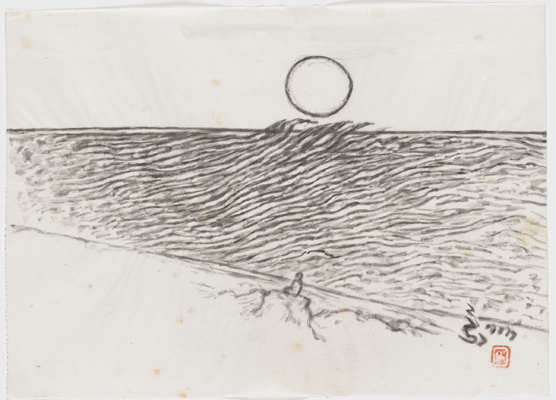Curatorial fellow Stephanie Rozman and conservation fellow Liz Sorokin recently collaborated to prepare a new installation of paintings by Indian artist Nandalal Bose (1883–1966). And from the outset, each fellow had distinct aims.
Sorokin, the Craigen W. Bowen Paper Conservation Fellow in the Straus Center, wanted to conserve and treat many of the 13 works by Nandalal in the museums’ collections, which would enable Rozman to select the objects that best served curatorial purposes. Rozman, the Calderwood Curatorial Fellow, knew she wanted the installation to explore the body of work that Nandalal created in the style of Japanese sumi-e (ink paintings).
Nandalal “was someone who was keenly interested in the traditions of art making that have been practiced over time throughout Asia,” Rozman said. “A lot of artists are recognized for iconic styles or periods. He was someone who really eschewed that.”
Nandalal’s introduction to Japanese ink painting early in his career (when he was a student at the Government School of Art in Calcutta) led to a lifelong interest in that medium. A 1954 painting, for instance, demonstrates his experimentation with Japanese techniques, such as diluting ink to achieve different tones and manipulating brushstrokes to create textures, as well as his interest in Japanese subjects, such as mountains shrouded in clouds.
At the same time, his ink paintings clearly drew on his experiences. A 1959 painting of figures picnicking near a riverbank recalls Nandalal’s work as an art teacher at Visva-Bharati University in northwestern Bengal, when he would arrange excursions in the surrounding countryside for students.
Upon arrival in the Straus Center, many of Nandalal’s ink paintings bore scattered and irregular brown stains (likely the result of a substance in the paper darkening unevenly as the paper aged) and also had significant undulations in the sheets. Sorokin and Penley Knipe, the Philip and Lynn Straus Conservator of Works of Art on Paper, conferred with Rozman and Mary McWilliams, the Norma Jean Calderwood Curator of Islamic and Later Indian Art. They discussed the artist’s intentions and practices, as well as the safest ways to conserve each object.
Sorokin set out to reduce the stains with a dilute cleaning solution of ammonium citrate in water (a solution shown to reduce staining while being safe for paper). She used a highly absorbent blotter paper to wick up the solution, and along with it, some of the stains. After that, Sorokin used a dilute bleach to further reduce discoloration. The final step was rinsing the paper with de-ionized water to ensure that no chemicals were left behind.
While the treatment was effective in improving the appearance of the works, it added some undulations to the paper—which already had a wavy appearance as a result of the artistic process. “When Nandalal created the paintings, he knew the paper reacted to moisture and he embraced that,” Sorokin said. She removed some of the newly induced undulations by applying humidity to each sheet, and then allowed them to dry in a controlled manner.
The results have been exciting for both fellows. For Rozman, the project provided an education in paper conservation. For Sorokin, learning about the works from a curatorial standpoint—and continuing discussion throughout the treatment—ensured “that we had the same expectations for the outcome, and that the treatment served to further highlight the artist’s work while respecting his process and intentions.”
The installation of four of Nandalal’s conserved paintings will be on view until November, near selections of paintings from South Asian and East Asian traditions. (Note that the images that accompany this article were taken before the paintings were treated.)


